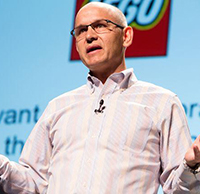 There are two widely-recognized routes to innovation: incremental improvement and revolutionary disruption. Describe what you call ‘The Third Way’.
There are two widely-recognized routes to innovation: incremental improvement and revolutionary disruption. Describe what you call ‘The Third Way’.
These two traditional types of innovation are still really important: We should always be thinking about how to improve our products and services for current customers; and we should also be thinking about the big disruptive forces in
our industry and society, and how to embrace them. But innovation leaders need a more complete tool box than just a hammer and a screwdriver.
As I looked around, I noticed some companies doing things that didn’t fall neatly under either incremental or radical innovation. This was a different approach, whereby you surround your product with complementary innovations that make the core product even more valuable. If your core product is no longer new and your company is simply satisfying the same need it has satisfied for many years, you should consider this approach.
You have studied how Gatorade adopted this route. Describe its ‘third-way journey’.
Gatorade actually invested in disruptive innovation by developing a new chemical that would help people process oxygen more efficiently. If it had worked, it would have changed the future of sports hydration. The problem was, the chemical was only available from one Brazilian forest. It turned the drink a very toxic looking yellow colour, and you had to drink about a keg of it to get any benefit. So, this attempt at disruption failed.
The company had also tried incremental innovation, by spinning out interesting new flavours. But that didn’t work either, because every time they added a flavour, they were adding cost, but not increasing sales.
Sarah Robb O’Hagen took over the struggling brand in 2008, in the midst of the recession — at a time when people were substituting Gatorade for the cheaper Powerade brand or plain water. Under O’Hagen, they tried the Third Way: They took a close look at what serious athletes care the most about, and the answer was, their performance. They realized that they could help these athletes out before, during and after the sporting activity — not just during it. So, they came up with the G Series of energy chews, sports bars and protein shakes. That’s when people really came back to the brand and sales of the core drink increased.
We need to be humble about our ability to predict when an innovation is going to work and when it’s not.
Of course, there was nothing especially innovative about sports bars or protein shakes. The key was that they tied these into a total package, making them part of a larger portfolio. When you do this, you can enter the realm of ‘higher purpose’, because together, your products contain a promise to the user. Each element has a dual purpose: To be good on its own, and also to help support the overall portfolio.
The promise to the user is a key element in the Third Way. What makes for a compelling promise?
I deliberately don’t use the term ‘brand’, because that is a broader term. The promise has to be consistent with the brand, but it is a tighter thing: It’s more about focusing on what your customers are trying to accomplish with your product. GoPro wants to help you capture your greatest adventures; and Gatorade wants to help you perform better as an athlete.
The Third Way is not the right response in every setting. When does it work best?
One thing we’ve learned is that we need to be humble about our ability to predict when an innovation is going to work and when it’s not. We should always be trying to make our current products better and recognize if there’s a new disruptive technology out there, and we should always be looking at new markets. But, in addition to these things, we need to be asking, ‘Are there things that we could be doing around our product?’ In most cases, people don’t think about that.
Steve Jobs is viewed by many as a disruptive innovator; but you disagree. Please explain.
He was definitely disruptive, but he wasn’t looking to disrupt. In 2001, when he brought out iTunes and the iPod, his goal wasn’t to change the music industry: It was to sell more Mac computers. What he wanted to do was to ‘help people manage their digital lives’ — that was how he phrased it. At the Macworld conference in 2001, he came out with a diagram that showed the Mac computer surrounded by all kinds of digital devices: CD players, VHS movie players, video cameras and palm pilots. He told the crowd, ‘Your lives are becoming more digital, and we’re going to help you with that, starting with music.’
In the Walter Isaacson book, he talks about how Jobs resisted taking iTunes to the IBM platform. That is not the action of someone who wants to transform the music industry. That is the action of somebody who wants to sell more Macs by making them more valuable. Even though customers were demanding that he bring iTunes over to the IBM platform, he resisted, because it wasn’t about disruption. It was about complementing his core product.
Describe how LEGO overcame a classic case of ‘binary thinking’ about innovation.
LEGO had the luxury of a crisis. Like Gatorade, it had tried to focus on the two classic types of innovation, and almost went bankrupt in the process. For most of its history, LEGO was quite comfortable just putting out a better box of bricks. That worked — until it didn’t. Then it tried to do some really radical innovation, moving away from bricks. It produced a stream of diverse new products, including electronic toys for toddlers, a virtual brick-building simulation and lines of toys around two blockbuster movie franchises, Star Wars and Harry Potter. The latter did very well while these movies were in wide release, but sales nosedived once they were no longer in theatres.
LEGO had long been associated with a few central products, and when it moved away from them, customers had no reason to do business with the company. Close to bankruptcy, it had no choice but to try something else, and it hit upon The Third Way: Bionicle was a set of plastic pieces that required assembly to construct an action figure. This was a new type of construction toy for LEGO, and these boxes of plastic pieces were surrounded with complementary innovations: comics, books, a video game and more. None of these related innovations would have succeeded alone, but each made Bionicle even more appealing to its target audience. This was literally ‘the toy that saved LEGO’: It sold 190 million units over the toy’s nine-year life span and was ‘rebooted’ in 2015.
Cheap, knowledge-generating, low-risk experiments are the best way to get really good feedback.
I would advise companies that don’t have the luxury of a crisis to go to their customers to find the crisis. Go out and spend some time trying to understand not just what your customers think of your product, but what they are trying to achieve. What are their frustrations? What are their challenges? And, based on that, see if you can’t do more for them beyond what your current product offers.
Learning from customers requires an intimate understanding of the human context in which a product is used. What is the best way to achieve that?
There are different ways to look at the context around your product, and I would urge innovators to try a number of approaches. I love the Jobs-to-be-Done framework from Anthony Ulwick; and I also really like the Consumption Chain mapping that Rita Gunther McGrath and Ian MacMillan created. That’s a wonderful framework for looking at things from a very different perspective — looking not so much at the activities around a customer using the product, but rather, the activities around the purchase process, which is different from the Jobs-to-be-Done framework.
You have said that the Third Way requires a high degree of humility on the part of practitioners. How so?
The more research we do, the more we find that predicting innovating successfully is really difficult. Hugh Molotsi,who ran the incubator at Intuit, came up with the analogy of the hippo: These animals are the most dangerous in Africa, because they’re so territorial, they run very fast and their bite is very strong. As a result, they kill more people than any other mammal in Africa. But Molotsi pointed out that ‘hippo’ is also an acronym for ‘highest-paid person’s opinion’. When people are trying to decide whether or not to proceed with an innovation program, they look around the room and everybody looks at the highest-paid person to get their opinion.
The key is to convince hippos that they are dangerous. If you are that hippo, you’ve got to have the strength and humility to say, ‘I really don’t know. Let’s go and ask our customers’. Cheap, knowledge-generating, low-risk experiments are often the best way to get really good feedback, and are often the best predictor of whether something is going to be successful or not.
I advise people to start by visiting their long-standing customers and watch their products in use. How do people derive value from your products? What problems or frustrations do they face? By visiting customers, you just might discover a more compelling promise — as well as complementary innovations that could help you deliver on that promise.
David Robertson is a Professor of Practice and teaches Innovation and Product Development at The Wharton School of the University of Pennsylvania. He is the author of
The Power of Little Ideas: A Low-Risk, High-Reward Approach to Innovation (Harvard Business Review Press, 2017).
This article appeared in the Winter 2018 issue. Published by the University of Toronto’s Rotman School of Management, Rotman Management explores themes of interest to leaders, innovators and entrepreneurs.
Share this article: